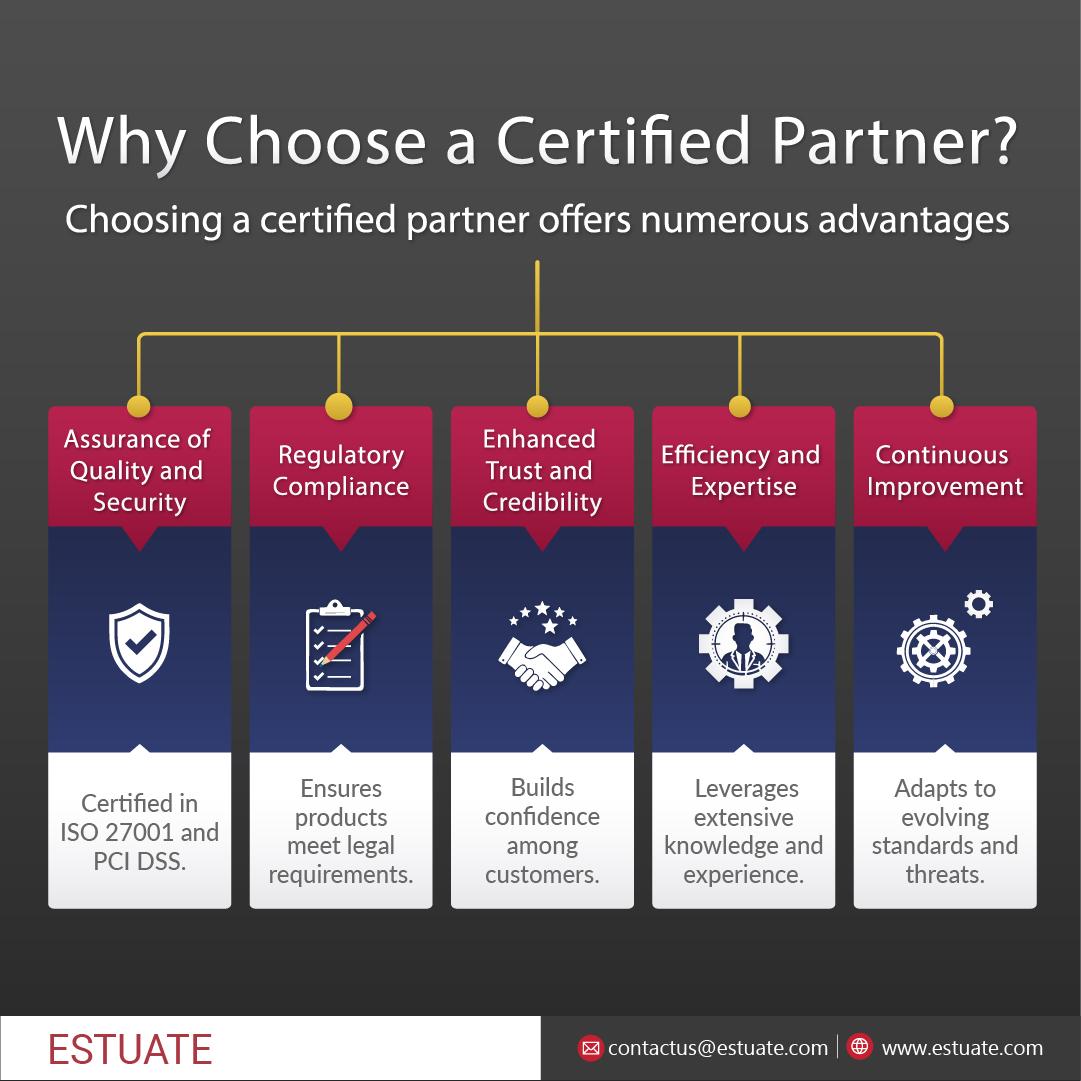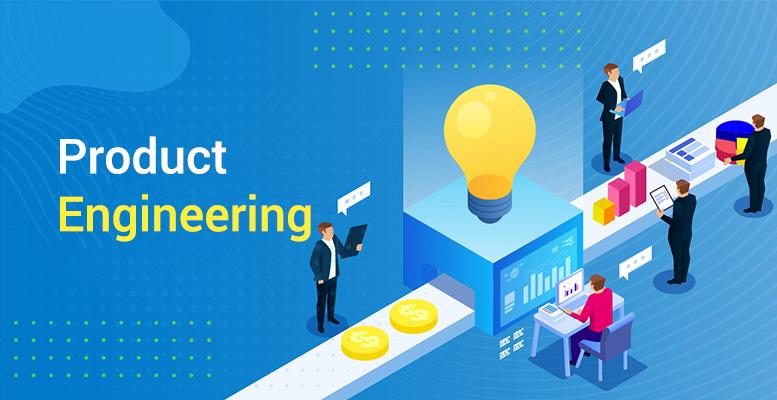
In today’s digital landscape, where data breaches and regulatory scrutiny are ever-present, mastering compliance in product engineering is not just a goal but a necessity. Whether you’re developing software, hardware, or integrated systems, adherence to regulatory standards not only safeguards your products but also builds trust with customers and stakeholders.
According to recent studies, 68% of organizations experienced at least one data breach in the past year, underscoring the critical need for robust compliance measures. Furthermore, companies that fail to comply with regulations face an average fine of $14.82 million, emphasizing the financial risks associated with non-compliance.
“68% of organizations experienced at least one data breach in the past year.”
Future-Proof Your Product
AI, automation, cloud—Estuate’s expertise ensures you stay ahead
in the tech race.
This blog explores the importance, strategies, challenges, and future trends of mastering compliance in product engineering. From understanding key regulations and implementing robust compliance frameworks to addressing common challenges and anticipating future trends, we delve into how companies can ensure their products meet regulatory requirements while maintaining innovation and efficiency. Join us as we navigate the complex but crucial terrain of compliance in the ever-evolving field of product engineering.
1. Introduction
Compliance in product engineering refers to adhering to industry standards and regulations throughout the product development lifecycle. It encompasses various certifications and frameworks that ensure products meet security, privacy, and operational standards. Key standards include the Payment Card Industry Data Security Standard (PCI DSS) for payment processing security and ISO 27001 for information security management.
2. Understanding Key Compliance Standards
PCI DSS: The Payment Card Industry Data Security Standard (PCI DSS) is essential for any organization that handles credit card information. This standard outlines detailed requirements for the secure processing, storage, and transmission of cardholder data. So, why is PCI DSS so important?
Imagine you’re running an e-commerce site. Every time a customer makes a purchase, they’re entrusting you with their sensitive financial information. PCI DSS helps you protect this data through a set of rigorous security measures. For example, it requires robust encryption methods to ensure data is unreadable to unauthorized users. It also mandates maintaining secure networks to prevent unauthorized access, regularly monitoring and testing these networks to spot vulnerabilities, and establishing strong access control measures to ensure only authorized personnel can access sensitive information.
By adhering to PCI DSS, not only do you protect your customers’ data, but you also significantly reduce the risk of data breaches and fraud. This builds trust with your customers and protects your brand’s reputation in the competitive digital marketplace. Plus, in many regions, compliance with PCI DSS is not just a best practice but a legal requirement, meaning non-compliance can lead to hefty fines and legal consequences.
In short, PCI DSS is about more than just ticking boxes; it’s about creating a secure environment for financial transactions and demonstrating your commitment to safeguarding customer data.
ISO 27001: When it comes to safeguarding sensitive company information, ISO 27001 is the gold standard. This international standard focuses on information security management systems (ISMS), offering a systematic approach to managing and protecting sensitive information.
So, what exactly does ISO 27001 entail? Imagine you’re running a company with valuable intellectual property, customer data, and operational secrets. ISO 27001 helps you create a robust framework to protect this information from threats like cyber-attacks, data breaches, and even insider threats.
The beauty of ISO 27001 is that it’s not just about technology; it’s about creating a culture of security within your organization. It requires you to identify potential risks, implement controls to mitigate those risks, and continuously monitor and improve your security measures. This might include everything from ensuring secure access controls and encryption to training employees on security best practices and establishing incident response protocols.
By adopting ISO 27001, you demonstrate a serious commitment to information security, which can be a significant trust factor for your clients and partners. They know that their data is in safe hands, and that your company is proactive in addressing security threats.
Moreover, achieving ISO 27001 certification can give you a competitive edge. It signals to the market that your organization meets international security standards, which can be particularly appealing to clients in regulated industries or those with stringent security requirements.
In essence, ISO 27001 is about much more than compliance; it’s about building a resilient, security-conscious organization that’s prepared for the challenges of the digital age.
3. Benefits of Compliance in Product Engineering
Ensuring compliance in product engineering is not just about adhering to regulations; it’s about enhancing security, building customer trust, and mitigating risks. Compliance with industry standards brings numerous benefits that significantly impact your organization’s success and sustainability. By embedding compliance into your product development processes, you safeguard your products, drive operational excellence, and achieve market differentiation. Compliance often leads to more efficient and secure product design, enhancing your reputation and fostering long-term business growth. Here are some key benefits of compliance in product engineering:
Enhanced Security
Compliance standards enforce rigorous security measures, protecting products from vulnerabilities and cyber threats. For instance, according to a report by Cybersecurity Ventures, cybercrime is expected to cost the world $10.5 trillion annually by 2025 [source: Cybersecurity Ventures]. By adhering to standards like PCI DSS and ISO 27001, organizations can significantly reduce the risk of becoming part of this statistic. These standards mandate robust security practices such as encryption, secure access controls, and continuous monitoring, which help shield your products from potential threats.
Customer Trust
Meeting compliance standards is a powerful way to demonstrate your commitment to data protection. When customers see that your organization complies with established standards, it builds confidence that their data is safe with you. In fact, a survey by PwC found that 85% of consumers would not do business with a company if they had concerns about its security practices [source: PwC Consumer Intelligence Series]. Compliance can be a key differentiator in a crowded market, helping you earn and retain customer trust and loyalty.
Risk Mitigation
Compliance helps mitigate legal risks and potential financial penalties associated with non-compliance. Non-compliance can lead to hefty fines, legal action, and significant reputational damage. For example, GDPR violations can result in fines of up to €20 million or 4% of global annual revenue, whichever is higher [source: GDPR.eu]. By ensuring compliance with relevant standards, you can avoid these severe consequences. Moreover, a compliant organization is better prepared to handle incidents and breaches, minimizing downtime and financial loss.
4. Strategies for Achieving Compliance
Establishing a Compliance Framework: Integrate compliance requirements into the product development process from inception to deployment. This means defining compliance objectives early on, identifying relevant standards and regulations, and embedding these requirements into your product lifecycle. By doing so, you ensure that compliance is not an afterthought but a foundational aspect of your development process. This approach helps in systematically addressing compliance needs and avoiding costly redesigns or delays later in the project.
Agile Integration
Incorporate compliance checkpoints into agile development cycles, ensuring continuous alignment with standards. Agile methodologies are designed for flexibility and iterative progress, making them ideal for incorporating compliance into your development workflow. For example, by setting up regular compliance reviews at the end of each sprint, you can quickly identify and address any compliance issues. This approach not only keeps your development on track but also ensures that your product consistently meets compliance standards, reducing the risk of last-minute non-compliance discoveries.
Cross-functional Collaboration
Foster collaboration between engineering, security, and compliance teams to streamline compliance efforts and address challenges effectively. Compliance is a multidisciplinary challenge that requires input from various experts. By creating cross-functional teams, you can leverage the expertise of engineers, security professionals, and compliance officers to create comprehensive and effective compliance strategies. Regular meetings and integrated project management tools can facilitate communication and ensure that everyone is on the same page. This collaborative approach helps in anticipating potential compliance issues early and developing innovative solutions to address them.
For instance, a survey by McKinsey found that companies with strong cross-functional collaboration are 1.6 times more likely to achieve successful digital transformations [source: McKinsey & Company]. This indicates that fostering teamwork across different functions not only enhances compliance but also drives overall project success.
5. Challenges and Considerations
Navigating the landscape of compliance in product engineering is fraught with challenges and requires careful consideration of several key factors. Ensuring that products meet regulatory standards involves complex processes, continuous vigilance, and substantial resource investment. It is not only about meeting current requirements but also about staying agile to adapt to future changes in the regulatory environment. Organizations must strike a balance between maintaining compliance and fostering innovation to remain competitive. By addressing these challenges head-on, companies can turn compliance into a strategic advantage, enhancing their reputation and operational resilience.
Complexities in Compliance
One of the biggest challenges for product engineering teams is keeping up with the constantly evolving regulatory landscapes. Different regions and industries have their own unique sets of regulations, which can be complex and difficult to interpret. For example, GDPR, CCPA, and HIPAA each have specific requirements that must be met. Staying updated with these changes requires ongoing education and a proactive approach. Additionally, interpreting how these regulations apply to specific products or services can be challenging, requiring legal and compliance expertise to ensure accurate implementation. This complexity can slow down development processes and increase the risk of non-compliance.
Continuous Monitoring
Maintaining compliance isn’t a one-time effort; it requires continuous monitoring and regular audits. As standards evolve and new threats emerge, organizations need to ensure that their products remain compliant. This involves setting up robust monitoring systems to track compliance status in real-time and conducting periodic audits to identify and rectify any lapses. Continuous monitoring helps in quickly addressing vulnerabilities and ensuring that security measures are up-to-date. However, this can be resource-intensive, requiring dedicated personnel and advanced monitoring tools. The challenge is to balance the need for thorough oversight with the agility required for product development.
Mastering compliance in product engineering is a continuous journey that requires proactive measures, collaboration, and adaptation to evolving regulatory requirements. By prioritizing compliance from the outset and integrating it into development practices, organizations can not only mitigate risks but also enhance product security, build customer trust, and achieve sustainable business success in today’s digital era.
6. The Importance of Choosing a Certified Product Engineering Partner
When selecting a product engineering partner, it’s crucial to choose one that is certified in key compliance and security standards. Here’s why:

Why Choose a Certified Partner
Assurance of Quality and Security
Certified partners, like Estuate, have demonstrated their commitment to adhering to rigorous industry standards such as ISO 27001 and PCI DSS. This certification assures you that they follow best practices for information security and data protection, significantly reducing the risk of data breaches and other security incidents.
Regulatory Compliance
Working with a certified partner ensures that your products are developed in compliance with relevant regulations. This is particularly important in industries with strict regulatory requirements, such as finance, healthcare, and e-commerce. A certified partner helps you avoid hefty fines and legal repercussions associated with non-compliance.
Enhanced Trust and Credibility
Certification is a mark of credibility and trustworthiness. By choosing a certified partner, you signal to your customers and stakeholders that you prioritize security and compliance. This builds confidence in your products and services, enhancing your reputation and customer loyalty.
Efficiency and Expertise
Certified partners have undergone rigorous training and audits to achieve their certification. This means they possess a high level of expertise and are well-versed in the latest security protocols and compliance requirements. Their knowledge and experience lead to more efficient processes and higher quality outcomes for your product development projects.
Continuous Improvement and Risk Management
Certified partners are committed to continuous improvement and regular audits. This ongoing commitment ensures that they stay current with evolving standards and emerging threats, helping you maintain compliance and manage risks effectively over time.
“By choosing a certified partner, you signal to your customers and stakeholders that you prioritize security and compliance.”
In summary, partnering with a certified product engineering firm like Estuate not only ensures that your products meet the highest standards of security and compliance but also provides you with peace of mind. You can focus on innovation and growth, knowing that your compliance needs are in expert hands.
7. Why Choose Estuate as Your Product Engineering Partner
Choosing Estuate as your product engineering partner means you are selecting a team that excels in compliance and security. Our expertise in ISO 27001 and PCI DSS ensures that your products meet the highest standards, protecting sensitive data and minimizing risks.

Important Certifications Held by Estuate
Build. Scale. Innovate
Partner with Estuate for high-performance, secure, and scalable product engineering solutions.
Let’s Talk!
We integrate compliance into every stage of development, leverage advanced security solutions, and foster cross-functional collaboration to deliver secure, compliant products. Trust Estuate to help you navigate the complexities of compliance and focus on innovation with confidence.
Learn more about our certifications and product engineering services.


